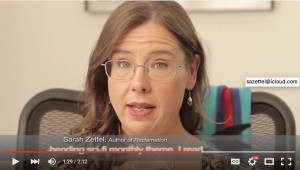Archive for book reviews
Sarah Zettel and the Big Book — Part Five
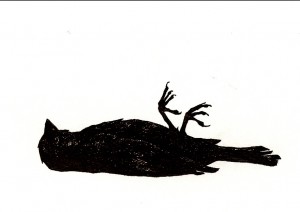 THE DEAD CHICK
THE DEAD CHICK
NOTE: I’m going to be talking unromantically and uneuphemistically about sex here, and ranting a bit. If you’re under 18, there are people who will think you shouldn’t read this. Please consult your own conscience and tolerence levels.
Okay. Here we go.
I have a problem with the end of The Big Book.
There was a lot to like here. The historical writing was particularly luscious. There are passages I want to shove under the nose of a number of authors I could name and say “See? See? Here. THIS is how you write about women and their friendships. This. Right here.” In parts there is a de-romanticization of the way men see women, that famous “male gaze” that is interesting, worthwhile and highly self-aware.
Then we get to the end, and what happens?
Wait for it…
I don’t expect a whole lot of people to read this book, if they can find it, but because this is the internet, I’m going to do this anyway.
SPOILER ALERT!
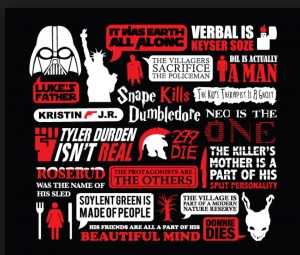
Okay? Okay. Oh, BTW, there’s also a rant coming.
Okay? Okay.
So, we get to the end, and what happens?…wait for it…In this time-looping book where we slip from present to past, between points of view and narrative styles and complexity, we get the most prosaic possible ending for the heroine. That’s right. The modern girl dies.
Why does she die? Because that’s what happens to abused women. Everybody knows that. Take a look down the line in movies and literature. When nobody can save them, they die.
Oh, it’s all terribly tragic. Just like that masterpiece of modern feminism, Thelma and Louise. This brilliant young woman is so unable to overcome the abuse inflicted on her by her father, and the exploitation of her professor, etc., that despite her brilliance and the discovery of genuinely good people in her life, and getting to be in the place she’s always wanted to be and meeting the kinds of people she’s always wanted to meet, she kills herself. Why? Well…because she does. It’s the tragedy of it, isn’t it? She was abused and she killed herself. That’s what happens, right?
And the author really piled it on. He made it very clear that this was in the end no garden variety abuse, and that, of course it wasn’t her fault, she was so traumatized, etc., she just kept seeking out situations where she was going to be abused. You know, it was one of those long, drawn out suicides.
For the record, I am very, very aware that exploited women do kill themselves. But you know what? They also don’t kill themselves. They suffer and they die, but they also suffer and live. Kind of a lot. But you wouldn’t know it from literature.
I am so, so, SO sick of the dead chick ending. It is not a new statement. It goes back centuries. Woman has a voluntary or involuntary sexual experience that is not within the codified bounds, and BOOM! Gotta die. Either because deviating from the strict code of conduct set by society has got to be seen as suicidal, or because it’s so, terribly, terribly, terribly tragic.
Oh, if she gets pregnant, maybe she gets to live for the baby’s sake, but living just because she wants to live? Not so much.
Maybe it was worth is when Thomas Hardy was writing Tess of d’Ubervilles, but in the 21st it’s cheap tragedy, right up there on the level with a story where the Big Surprise is that the hero’s gay. It’s also obvious tragedy. It’s easy. Of course she dies, because it was all. So. Horrible.
I’ll tell you something else — killing the victim it is NOT a feminist or feminist-ally statement. You know what would be? If the victim lived. If she survived what had happened and somehow managed to heal, even a little, without having to go through being pregnant for the privilege. If the exploitative professor was forced to confront the living woman, rather than just the corpse. THAT would be a profound statement.
Or if he died instead. You’ll notice the man never dies in these scenarios. He never kills himself because he can’t handle what he’s done or what he’s learned. Ever wonder why the woman is always the one who’s got to die?
With all that was new and wonderful and beautifully written in this book about survival, and history and faith, about ways to fight and ways to cope, and the beauty of the world and THIS is the best this character we’ve spent over a thousand friggin’ pages with gets? A bland, dull, worn out repetition of one of the oldest and most worn out tragedies. So sad. Next.
Close the Big Book on a sour note.
Sarah Zettel and the Big Book — Part Four
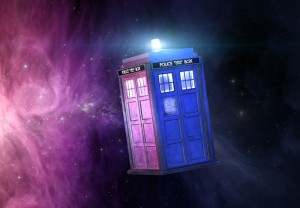 NO MORE TIME TRAVEL THAN STRICTLY NECESSARY PLEASE
NO MORE TIME TRAVEL THAN STRICTLY NECESSARY PLEASE
THIS POST CONTAINS SPOILERS FOR THE BOOK REVOLUTION BY JENNIFER DONNELLY.
Okay? Okay.
So, I took a break from reading The Big Book and read a smaller book also on the 6ft tall TBR Pile of Doom — Revolution by Jennifer Donnelly. Overall, very good. Emotionally gripping. Wasn’t sure about it at first, the emo at the opening felt a bit…obvious. But it all settled down.
And then I found out that Revolution and The Big Book both pull a similar trick. Both jump from modern times to the past. Both have a modern person looking back at the life of a doomed historical person. Both portray the past very, very well, and weave the tension between past and present very, very well.
Then both insert a person from the present into the past — in the case of The Big Book via a play written by one of the modern protagonists, and in Revolution by an actual (or was it all a dream?) act of time travel, via the time honored means of the blow to the head.
In both cases, all that emotional tension drops out of the narrative like air out of a balloon. Both authors have done such a terrific job of creating the separate worlds, the separate problems and the separate POVs the change just feels cheap. Gimmicky. It’s a narrative layer I not only don’t need, I actively don’t want, because what I’ve got has been so lovely.
It’s a lesson about the importance of simplicity, even within complexity. Note to Self: Sometimes it’s worth it not to take that extra step, and flow, familiarity and follow through can be more important and more effective than that final twist.
And no more time travel than strictly necessary.
Sarah Zettel and The Big Book — Part Three
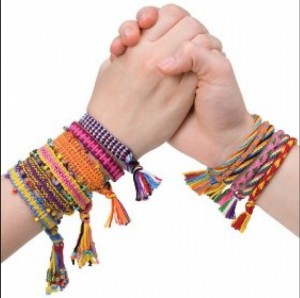 FRIENDSHIP
FRIENDSHIP
As you might expect, HUNGER’S BRIDES, otherwise known as The Big Book, is a complicated book. Wow, is it complicated.
It’s a time-jumping novel. Not time travel, but it divides its storyline between the story of a modern girl, mostly told from the point of view of her professor who was a self-excusing womanizer, and who was sleeping with her because she was pretty and didn’t think much of it (yeah, he’s a peach of a guy), and never bothered to understand that she had issues. Okay, not issues. She had subscriptions — abuse leading to anorexia and other self-destructive behaviors. The other part of the story of Sor Juana Inez Delacruz, who was a scholar and nun in the time of Imperial Mexico and ultimately falls afoul of the Inquisition.
It’s an ambitious trick, and when you’re doing it in 1300 pages, it’s pretty natural that some bits would succeed better than others. I want to talk about one of the places that really succeeds. The depiction of friendship.
Female friendship is something a lot of authors seem to grapple with. In SF, we’ve gotten used to seeing a woman paling around with the guys particularly if she’s a military officer, a kick-ass heroine of some sort, or a prostitute. But she’s on her own. She gets to be friends with the guys and fall in love with them, but friends with other women? Nope. Not there.
In The Big Book, there are lots of friendships for Sor Juana. Her life is not ideal. She’s tightly cloistered, but within the cloisters, she has a tight circle of friends, and Anderson portrays them very believably. They’re genuine, complicated, have good days and bad days, little secrets, little confidences, big blow ups, small ones, attempts to help that are sometimes clumsy, sometimes successful and always human. Not afraid of this strange world, not afraid to show these people as fully human.
It made me so happy. It’s a simple thing, but I can’t help thinking that the portrayal of friendship is startlingly absent from a lot of genre fiction, especially for women. It’s one of the reasons I love the Thor movies. Dr. Jane Whose-last-name-I-never-Remember has a friend, one who is roughly her age and is also a woman. They talk, they tease, they help each other out. Stop a second and do a count. What other genre movies have you recently seen where there’s a scene between women friends? Go ahead. I’ll wait. I’ve got the most recent Hunger Games, and even there it’s sketchy, and Frozen, which is between sisters. How about you?
Interestingly, the miserable, abused, self-destructive modern woman has no women friends, not currently. She meets up with an old friend during the course of the book but does not let herself stay with that woman. She doesn’t make any new female friends.
For all of us, gender aside, friendship is a huge part of our world. We get so caught up in talking about sexual relationships, we forget about the complexities, the intricacies, the vitality and absolute importance of friendship. We need to remember more, inside the genre and out of it.
Sarah Zettel and the Big Book — Part Two
TROPHIES
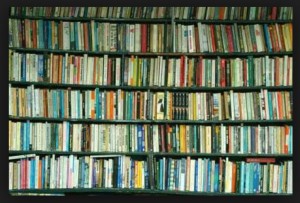 I belong to the Subculture of the Book. In my culture, books are not just containers for words, they are prizes, trophies, and they come with bragging rights. I have had whole conversations with friends about how many books we own, how many new bookshelves we’ve had to buy; the problem of trying to squeeze one more bookshelf into a small house or apartment; how many individual volumes we own and whether they’re double stacked on those shelves. We bemoan the difficulties of book storage and management in that particular way that is really kind of closer to bragging than actual regret. And we always buy more books. The size of your To Be Read pile is a big part of the Subculture of the Book.
I belong to the Subculture of the Book. In my culture, books are not just containers for words, they are prizes, trophies, and they come with bragging rights. I have had whole conversations with friends about how many books we own, how many new bookshelves we’ve had to buy; the problem of trying to squeeze one more bookshelf into a small house or apartment; how many individual volumes we own and whether they’re double stacked on those shelves. We bemoan the difficulties of book storage and management in that particular way that is really kind of closer to bragging than actual regret. And we always buy more books. The size of your To Be Read pile is a big part of the Subculture of the Book.
Ebooks have not changed any of this. That may be because I hang out with fellow geezers, but there you have it.
The Big Book is emblamatic of my culture. I did buy it because I was curious about the contents. But I also bought it simply because it was big and beautiful and I wanted it. Some people do this with shoes or cars. I do it with books. And clothes. But mostly books.
Lately, though, I’ve begun to question the subculture of the Book, and I hate to say, it’s in part because of the Big Book. It’s turned out to be a good book. There are parts of it that are really brilliant. But like I said in my previous post, this Big Book sat on my shelf for years, and it had plenty of company. That shelf? Let me show it to you. It’s six feet tall, four broad and it’s stuffed with books I haven’t read. And I keep buying more and piling them in. I mean there’s a TBR pile and there’s hoarding. If books were cats, the neighbors would have called the humane society by now.
A few years ago, I tried be systematic about things. I was going to start at the top left of the shelf and read every book in order. I mean, I bought them, right? I bought them because I wanted to read them, not just own them right? What is the point of a book you don’t read?
That effort, I confess failed miserably. So, there it sat, big and beautiful and completely unread, with all those other beautiful, unread books.
Books are a good thing. You can never have too many, right? This is practically the motto of the subculture of the Book. And yet…and I ask this seriously…what is the point of having more than you can read?
Has counting coup and the luxury of ownership become more important to me than the stories?
What am I Reading?
I’ve got a new addiction. It’s the John Ceepak mysteries by Chris Grabenstein.
I heard about these books in a segment on NPR, which described them as police procedurals set on the Jersey Shore, but what really grabbed me was the description of the hero. Far from creating yet another brooding cop who’d seen it all and been beaten down by it, Grabenstein created a man who had seen it all but come out on the other side determined to do and be better and to see the world not through rose colored glasses but through the lens of optomism rather than cynicism.
Intrigued, I went around the corner to pester the good folks at Aunt Agatha’s and took home the first book.
I fell in love.
These books are not exactly light, but they’re smart, they’re fun, they’re fast. The narrator’s voice is engaging and believable and clear. I love Danny, the partner who tells the stories and his relationship with this seaside town, and pretty much everybody in it. I love the way Grabenstein builds his main characters and fills in the complexity of their lives. I’ve been binging on them for the past couple of months, and I suspect I’m going to be very sad when I do finish.
Palace of Spies Scores Another Review
 It has been a terrific launch week for Palace of Spies. I cannot send out enough thanks to the folks who have taken the time to read the book and give it so many thoughtful, and enthusiastic review. Here’s just one of the latest up at I am Indeed.
It has been a terrific launch week for Palace of Spies. I cannot send out enough thanks to the folks who have taken the time to read the book and give it so many thoughtful, and enthusiastic review. Here’s just one of the latest up at I am Indeed.
13 Reasons to Read SF
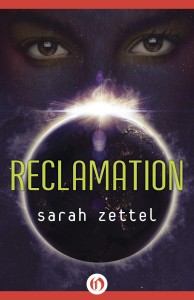 The original title of this post was 13 Reasons to Read SF by Women, and it appeared, in all it’s fearsome glory in the Huffington Post Book Blog.
The original title of this post was 13 Reasons to Read SF by Women, and it appeared, in all it’s fearsome glory in the Huffington Post Book Blog.
There’s a hazard in being a list poster, especially when you’re posting about a portion of the pop culture and literary landscape that’s been growing and changing for 200 years. There’s also the ongoing question of the necessity and utility of segregating art created by women from art created by men. But then again, this list drew some comments that made the need to keep at this a little clearer, including several where the commentors complained that SF written by men was not included on a list of SF written by women, and others who disparaged women SF authors as mostly writing romances and gothics. Speaking as a romance author…well, that’s a whole other post.
That said, here’s the article, and the original list. I think this is something I’m going to have to revisit and revise. One of the commentors suggested a list of 50, or 100. There are easily that many great works with women authors. One for this new century of ours would be great too, if only because I’d like to read the results myself.
THIRTEEN REASONS TO READ SCI-FI BY WOMEN
It was supposed to be Ten Reasons.
I tried. I really did. I just couldn’t get the list that short.
Actually, I have mixed feelings about these lists. I don’t believe there’s any good reason for sci-fi (or anything) created by women to be treated differently than sci-fi by men. If a book (or movie, or short story, or comic, whatever) is good, it’s good. If it’s not, it’s not, and the identity of the author shouldn’t matter. And if it wasn’t for the people who keep saying “I don’t read books by women,” or “women don’t write (or read), science fiction,” it might not. And do not get me started on the whole “fake geek girls” riff.
Sci-fi as we know it has been written around the world for at least two hundred years. So much of it is created by women that narrowing the list down to ten (or thirteen) titles was a challenge I was never going to be able to handle alone. So, I reached out across the internet for answers, especially into the places where I knew I’d find authors, editors, readers and geeks.
Here’s what the Internet said back. Keep in mind, this is not a complete list. This is barely the beginning.
FRANKENSTEIN, by Mary Shelley. We’re beginning at the beginning. This is widely acknowledged as the first sci-fi novel, and it’s story that has been embedded in pop culture for two hundred years.
COLD COMFORT FARM, by Stella Gibbons. Written in the 1930s, this is a hilarious send-up of English pastoral and gothic novels, and worth reading for that alone. It is also very definitely but subtly, science fiction.
NORTHWEST SMITH by C.L. Moore. This is actually an anthology. Moore was one of the most prolific writers of sci-fi’s pulp days back in the 1930 and ‘40s. If you liked Joss Whedon’s cult hit Firefly, or Speilberg’s Raiders of the Lost Ark, you’ll like Northwest Smith. “Shambleau” remains one of the world’s ickiest vampire stories.
THE WARRIOR’S APPRENTICE, by Lois McMaster Bujold. Sci-Fi adventure that skillfully blends, action, humor, and romance. If this list was arranged by number of Internet Votes, Bujold would have been duking it out with Butler, Shelley and LeGuin for top slot.
THE FEMALE MAN Joanna Russ Written during what was called the “new wave,” period of SF which rode the social changes of the 1960s and ’70, Joanna Russ was one of the most dangerous, and challenging of women sci-fi authors. This is a direct challenge to gender roles and perceptions wrapped in Russ’s smooth prose.
A THOUSAND WORDS FOR STRANGER by Julie Czerneda. Czerneda is fun. Her work has scope, excitement, brilliance and engaging characters.
THE HANDMAID’S TALE, Margaret Atwood. This book is a well-thought-out, beautifully crafted nightmare. I quote it regularly.
A WRINKLE IN TIME, by Madelaine L’Engle. I was given this book by my mother and I read it to my son. It not only holds up, it remains exciting, illuminating and scary.
HUNGER GAMES, by Suzanne Collins. Not only is this a good story, it’s a powerful reason for the renaissance happening in sci-fi right now, especially on the YA shelves.
PARABLE OF THE SOWER, by Octavia Butler. Butler was (and is) a hugely influential African American author with a brilliant writing style and an unrivalled ability to imagine the way her futures (and her pasts) shaped the lives of her characters. Sower is what I’d call a slow-dystopia novel. Civilization has collapsed, is collapsing, but it also being reimagined and rebuilt.
FULLMETAL ALCHEMIST, by Hiromu Arakawa. This isn’t a novel, it’s a manga, and an anime series (actually, several anime series plus video games). It’s also some of the best, most engaging sci-fi you’re ever going to read.
THE EMPIRE STRIKES BACK, by Leigh Brackett. Obviously not a novel. But, it is widely considered the best of the movies to date, and the brain behind much of that brilliance was the veteran female SF author and script writer.
THE LATHE OF HEAVEN, by Ursula K. LeGuin. I could have filled this list exclusively Le Guin titles. I’m going with this one, because it’s a book I give to people who think they don’t like sci-fi. It’s the story of a man whose dreams shape reality, and the psychiatrist who figures that out.
Some Honorable Mentions: Where the Late Sweet Birds Sang by Kate Wilhelm, Dreamsnake by Vonda N. McIntyre, Shattered by Robin Wasserman, Finity’s End by C.J. Cherryh, The House of the Scorpion by Nancy Farber, The Speed of Dark, by Elizabeth Moon, Her Smoke Rose Up Forever by James Tiptree, Jr. (Alice Sheldon), Grass by Sheri Tepper, Beggers in Spain by Nancy Cress, The Sparrow by Maria Doria Russell, The Doomsday Book, by Connie Willis
Enjoy.
My Own Reviews
The good ones anyway…
The latest is from Publisher’s Weekly and I’m delighted. The first book in my new YA historical series Palace of Spies comes out Nov. 5, and so far, there’s been a lot of love across the internet, including this one.
“Peggy’s voice is light and accessible, and the plot moves quickly. A solid opening volley in a promising series.”
Hurray!

